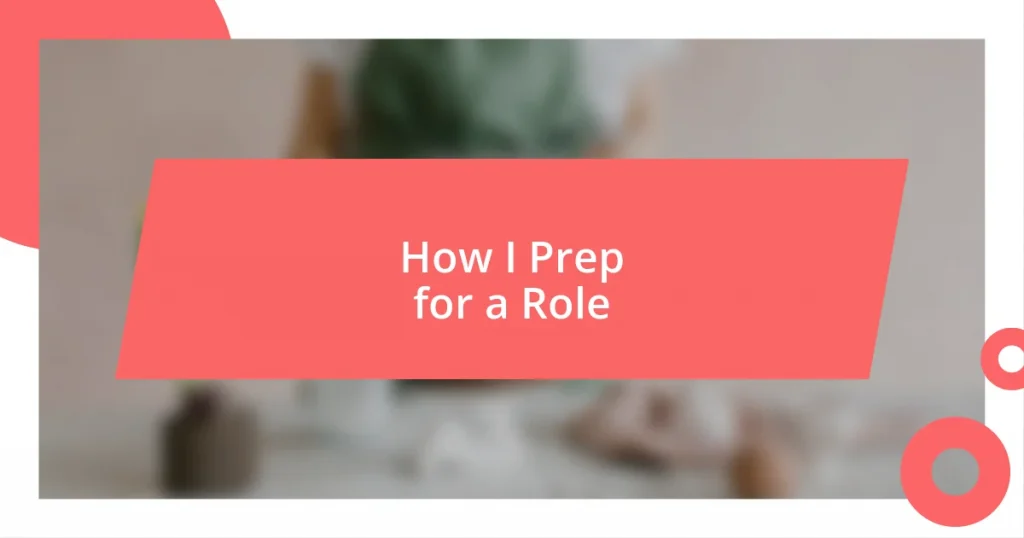Key takeaways:
- Understanding a character involves deep emotional exploration and creating a backstory that reflects their past experiences, which enriches performance authenticity.
- Effective role research includes reading extensively, engaging with experts, and exploring social contexts to deepen the connection with the character.
- Physical preparation, including movement practices and costume insights, significantly influences an actor’s mindset and portrayal of their character.
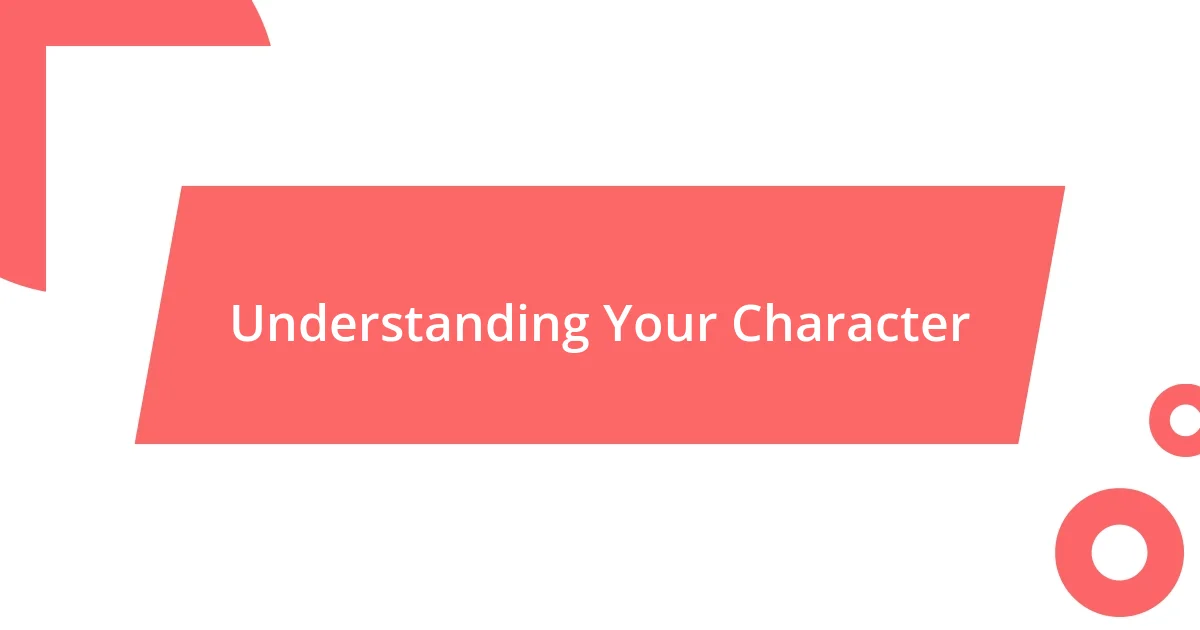
Understanding Your Character
Understanding your character is all about digging deep into their motivations and emotions. I recall preparing for a role where my character faced immense internal conflict. I had to ask myself, “What would I feel if I were in their shoes?” Answering this helped me find that emotional anchor essential for a genuine performance.
It’s fascinating to explore how characters are shaped by their backgrounds and experiences. I often jot down key moments in my character’s life that could define their thoughts and actions. For instance, consider how a childhood trauma might influence their relationships. We’re all products of our past; isn’t it intriguing to think about how our characters reflect that truth?
As I dissect my character’s traits, I find it helpful to engage in conversations with myself—almost like a dialogue. Imagine “interviewing” your character about their fears, dreams, and regrets. By empathizing with them this way, I often discover layers I hadn’t initially considered, which adds richness to my portrayal. What insights might you gain from a simple conversation with your character?
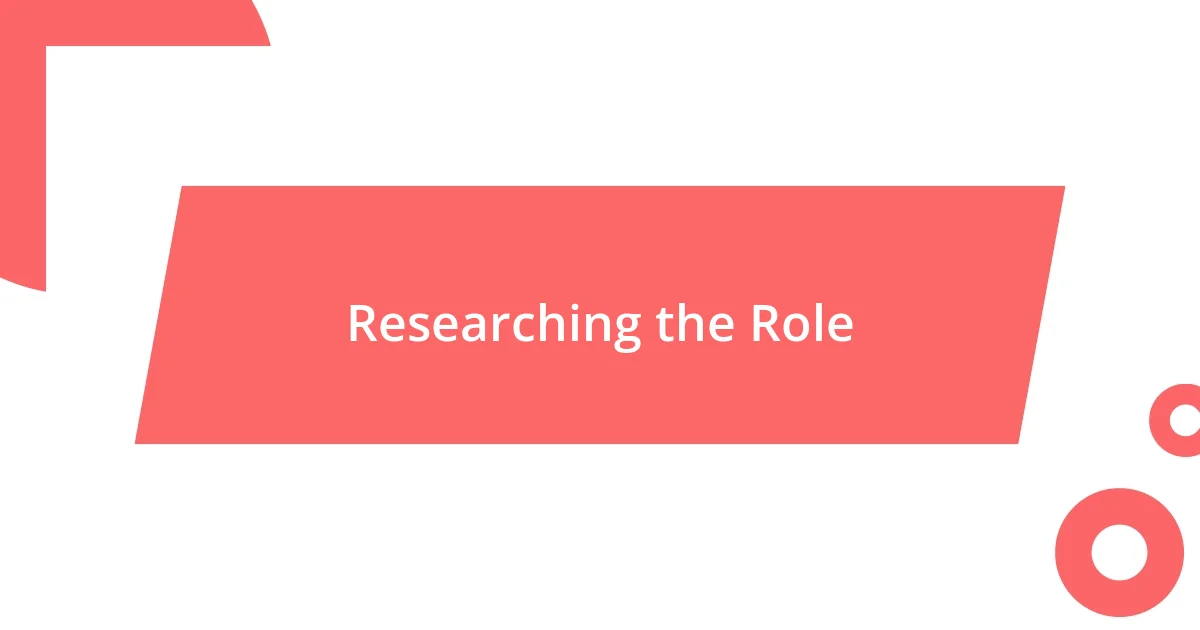
Researching the Role
Researching the role is a crucial step that ties everything together. I remember diving into the background of a historical figure I portrayed. The more I learned about their life—their struggles and achievements—the more I could embody their essence. This process isn’t just about facts; it’s about truly feeling their journey and understanding their place in the world.
Here are some effective strategies I use when researching a role:
- Read extensively: Biographies, articles, and interviews can unveil unique insights.
- Watch documentaries or films: Visual storytelling can provide context that written materials often miss.
- Engage with experts: Talking to historians, psychologists, or anyone knowledgeable about the character’s era can enhance authenticity.
- Explore social and cultural contexts: Understanding the character’s environment and its impact on their behavior is pivotal.
By immersing myself in these details, I not only enrich my performance but also create an emotional bridge that allows me to connect with the audience on a deeper level.
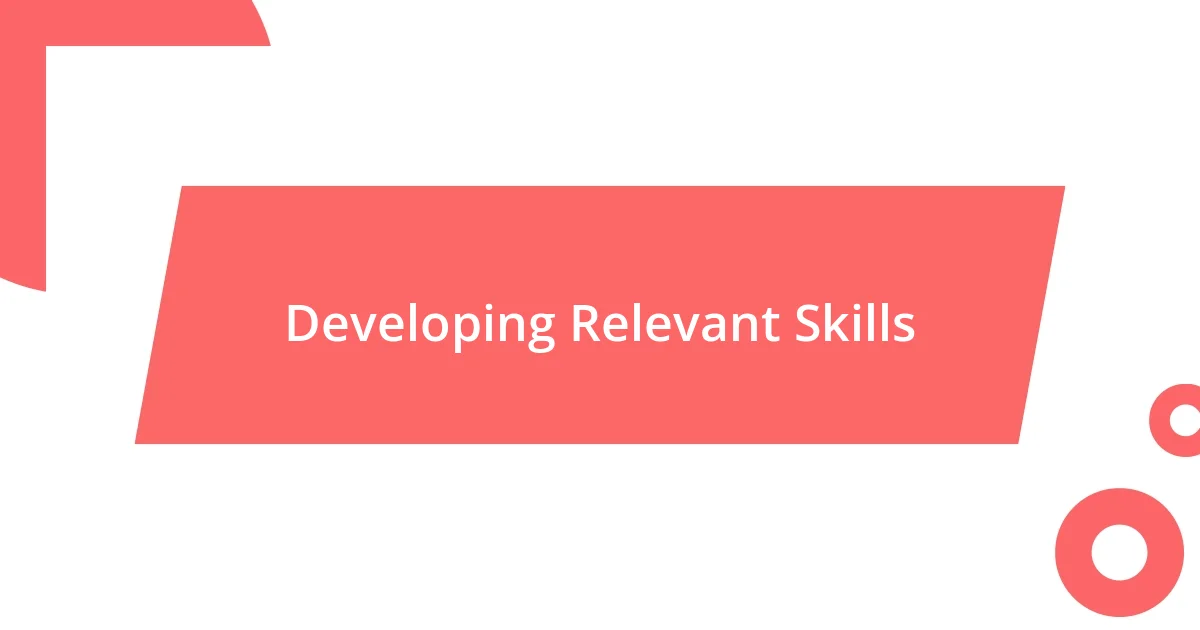
Developing Relevant Skills
Developing relevant skills is essential for effectively bringing a character to life. I’ve often honed my abilities through targeted workshops and courses. For instance, taking improv classes has not only sharpened my spontaneity but also built my confidence in portraying unpredictable characters. Isn’t it interesting how stepping out of your comfort zone can yield unexpected rewards in your craft?
One skill that particularly stands out is voice modulation. I recall preparing for a role where my character had to convey vulnerability while maintaining strength. By practicing different tones and pitches, I figured out how to give my character distinct emotional layers. It’s fascinating how a slight change in voice can affect the audience’s perception. What skills do you think you could develop to enhance your portrayals?
Lastly, I believe in the power of observation. Whether it’s watching people interact in a café or noting how my friends express excitement, these moments are invaluable. I once watched a stranger handle a stressful situation with grace—this inspired my portrayal of a character facing life’s pressures. Connecting the dots between real-life behaviors and my roles enriches my performance in ways I could have never anticipated.
| Skill Development Strategy | Example from Experience |
|---|---|
| Workshops/Courses | Improv classes for spontaneity |
| Voice Modulation | Practicing tones for emotional depth |
| Observation of Real-life Situations | Inspired character traits from observing behaviors |
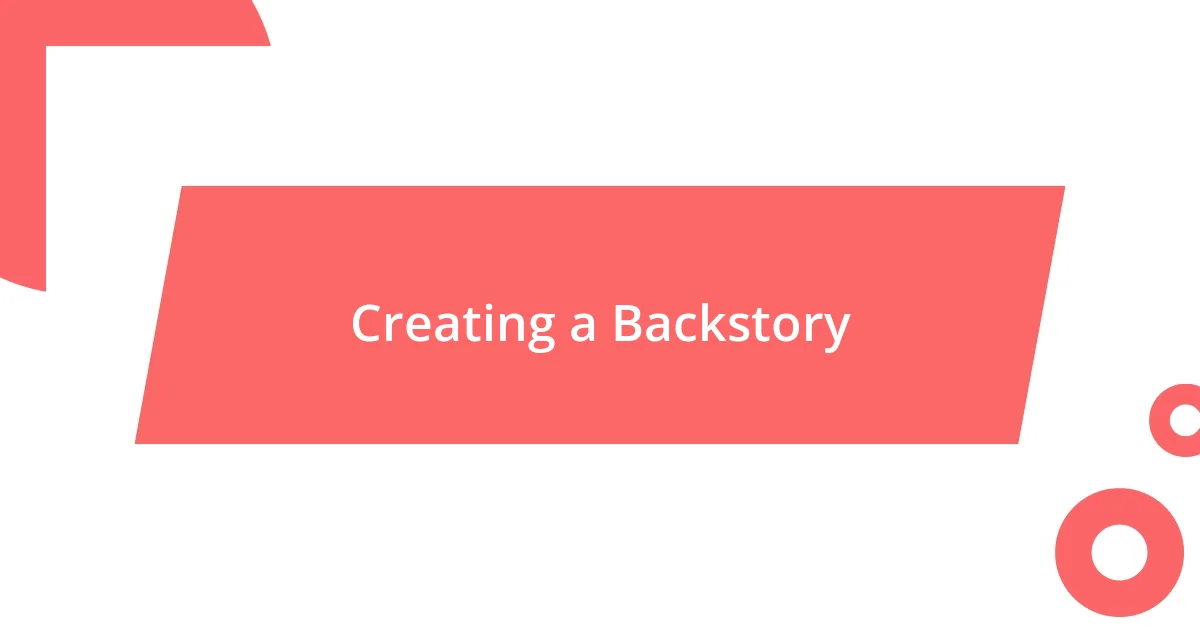
Creating a Backstory
Creating a backstory is like laying the foundation for a house; it gives structure and depth to everything that follows. I once played a character who experienced a significant loss in childhood, and I felt compelled to understand how such an event would shape a person’s worldview. I imagined what their home life was like, which memories would haunt them, and how they would react in different situations. This imaginative exercise not only fueled my performance but also allowed me to connect emotionally with the character in a way that felt genuine.
I often find myself asking, “What if?” while constructing backstories. For instance, I once created a character who was deemed an outcast due to their unique talents. I explored how that isolation would influence their decisions and relationships, leading to moments of desperation or triumph. Diving into these hypothetical situations helped me bring authenticity to my performance. It’s incredible how taking the time to craft backstories can breathe life into even the most complex characters.
Ultimately, the process of building a backstory keeps me rooted in the emotional truth of the character. I vividly remember preparing for a role where anxiety was a dominant trait. I drew on my own experiences when feeling overwhelmed, recalling that palpable sense of dread. By channeling those emotions into my character’s history, I found that not only did I portray anxiety more convincingly, but my connection with the audience grew stronger. How have your own experiences helped shape the characters you’ve played?
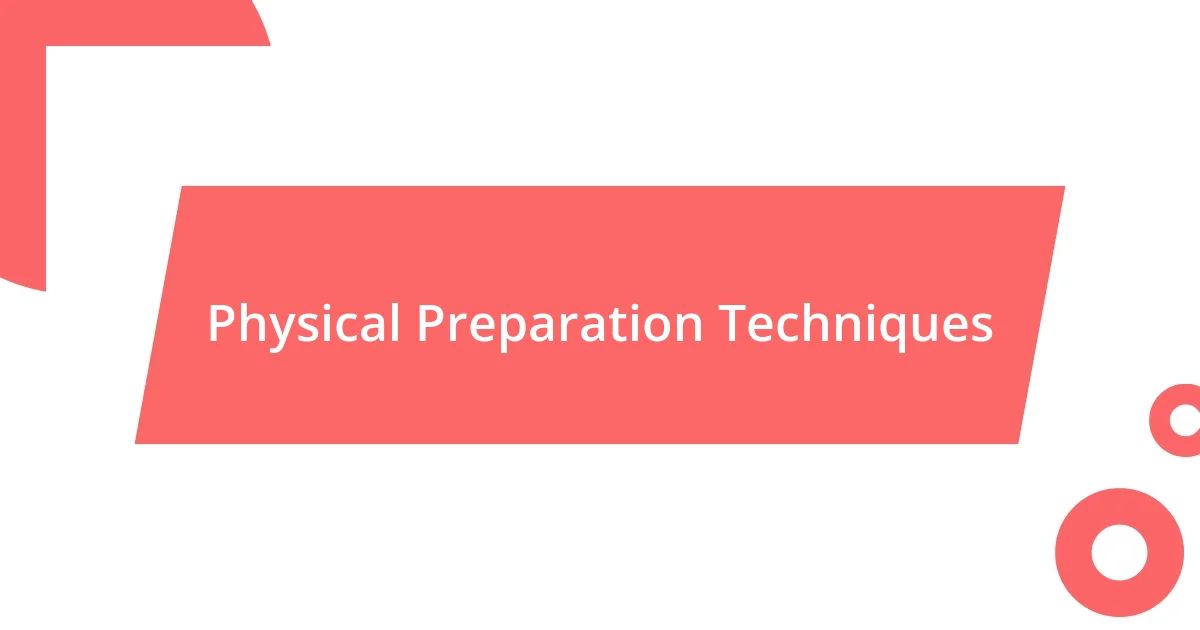
Physical Preparation Techniques

Physical Preparation Techniques
Physical preparation significantly impacts how I embody a character. I find that focusing on my body’s movement and expression before stepping into a role is crucial. For example, before portraying a character with a military background, I embraced a rigorous training routine, combining fitness with specific movement drills that mimicked their discipline and posture. It’s remarkable how adopting physicality can instantly shift your mindset and performance—hasn’t any movement you’ve tried made you feel different about yourself?
Stretching isn’t just about flexibility; it’s about connecting my mind and body. I recall a time preparing for a role where my character was always tense and on edge. In my practice sessions, I focused on deep breathing and yoga, which surprisingly helped me embody that nervous energy with authenticity. Sometimes, just a few minutes of mindful breathing can ground me and prepare me for the emotional load of a character.
Moreover, costume plays a pivotal role in my physical prep. When I don my character’s attire, it’s like flipping a switch; I instantly feel different. I remember the first time I wore a vintage dress for a period piece. It transformed my movements and attitude, making me walk and hold myself in ways that matched my character’s era. Have you ever felt how your outfit can change your entire demeanor? That feeling is real and a valuable tool in preparing physically for a role.
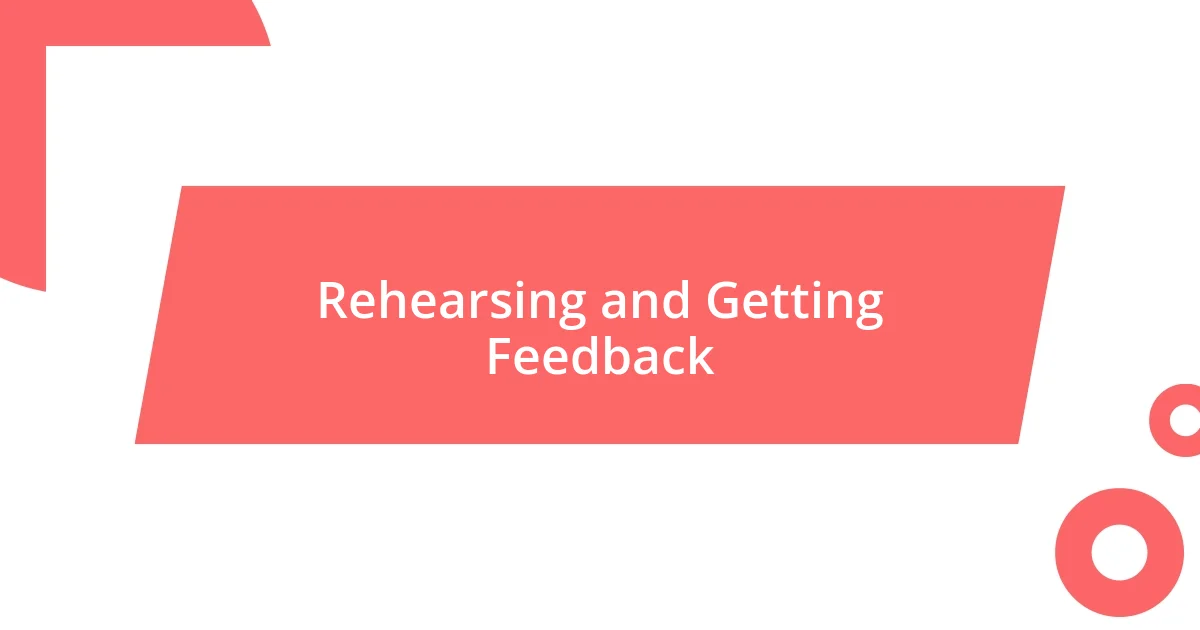
Rehearsing and Getting Feedback
Rehearsing isn’t just about repetition; it’s a journey of discovery. I remember when I was preparing for a role that required a lot of emotional nuance. Each rehearsal felt like unpeeling the layers of my character’s psyche. I would often run the same scene multiple times, experimenting with different emotional tones, and sometimes I stumbled upon a moment that caught me off guard. Have you ever experienced a breakthrough in rehearsals that transformed your understanding of a character? It’s those little revelations that make all the hard work worthwhile.
Getting feedback is equally essential in this creative process. Sharing my interpretations with fellow actors or a trusted director can be incredibly revealing. There was a time when I performed a pivotal scene and received feedback that I had delivered it too softly. At first, I was hesitant, but then I realized that portraying vulnerability does not mean underplaying intensity. The subsequent performances were stronger, and the character resonated more deeply with the audience. How do you handle feedback when it takes you outside your comfort zone?
Ultimately, I find that rehearsing and receiving constructive criticism are two sides of the same coin. During one production, I created a detailed emotional arc for my character, but feedback highlighted inconsistencies that I hadn’t noticed. Embracing that input was challenging, yet it spurred me to refine my approach. It became a valuable lesson: vulnerability in performance can lead to profound growth, both as an actor and as a person. What have your rehearsal experiences taught you about yourself?

Finalizing Your Performance Plan
When it comes to finalizing my performance plan, clarity is key. I often take a moment to jot down the core objectives I want to achieve with my character, detailing both emotional beats and physicality. For instance, before a recent role, I looked at each scene and asked myself, “What do I want the audience to feel here?” That focus helped pinpoint my approach and solidify my performance strategy.
Creating a timeline is another vital part of the process. I’ve found that scheduling rehearsals and checking in with my notes regularly keeps me on track. I remember a time when I left aspects of my preparation too late, leading to unnecessary anxiety. Learning to allocate specific time slots for character exploration and rehearsals has since transformed my confidence. How do you map out your preparations to ensure you’re ready when the curtain rises?
Lastly, I like to visualize the entire performance. I close my eyes and imagine each scene, picturing not just my actions but the emotions of the character and how they interact with others. This technique has often grounded me in my role. I recall vividly how this mental rehearsal helped me embody a character’s journey from despair to hope seamlessly. Have you ever found that visualizing a task actually made it feel more achievable? It’s a technique worth exploring when finalizing your performance plan.










